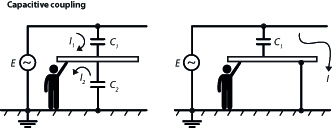
Impressed Voltages
‘Impressed voltages’ are a general, catch-all term used to cover induced or capacitive voltages appearing on metalwork. The term relates to the existence of a voltage on an item of equipment, or metallic object, which is not directly connected to the energised power system, but which has arisen as a result of an electrical coupling or from a residual charge at the time of circuit de-energisation or testing. Some voltages can be quite high and a hazard and must be eliminated before contact is made with the metallic object. These voltages can be a significant safety hazard to be managed and controlled on a construction site. It is not the intent of this article to identify the possible sources of these voltages or provide any guidance as to their possible magnitude, but merely to remind duty holders that the possible production of such dangerous voltages must be considered.
Perhaps the most widely known are 'induced voltages’, and general electrical theory shows that a changing current in a circuit can induce a voltage in another unconnected circuit, and the magnitude of this induced voltage depends on several factors including the relative disposition of the conductive parts of the circuit, their proximity and the current in the primary circuit.

A less well recognised effect is the possible capacitive coupling of two conductors to store charge between a live conductor (for example a HV overhead line) as well as allowing a current to flow when the other conductor forms a circuit, for examples someone touching metal scaffolding to allow a discharge to earth. Again the magnitude of this voltage depends on several factors including the relative disposition of the conductive parts of the circuit, their proximity and the voltage of the primary circuit.

There can also be ‘trapped charge’ arising from residual charge left on the capacitance of an item of equipment – for example after insulation resistance testing a length of cable.
Generally normal low voltage systems are not an issue, but there are possibilities where high lv currents can be found, for example substations, railway systems, large industrial processes etc and in such cases impressed voltages may appear on metalwork such as scaffolding, disconnected or newly installed cables not yet connected etc. and local earthing may be required. Capacitive coupling can occur near HV overhead lines or HV rail tracks etc and significant and dangerous voltages have been recorded on roadside traffic barrier works near HV overhead lines. Again suitable earthing must be provided for the metalwork to discharge these voltages.
These voltages may arise on either permanent works or temporary works and the designer and construction management must recognise their possible existence and plan for their safe elimination during the works. Scaffolding can be adequately earthed, but other items, especially mobile plant or materials being moved around site may require careful earthing considerations. Current flow through the earth (usually fault current) will create a voltage difference between two points, which may be remote from the path of current flow. Should a person come into contact with these points a possible danger from electric shock may arise due to the difference in potential between the two points – this is known as step or touch potential. But a potential can also be transferred to another unexpected area through site metalwork, for example through a chain link fence.
When considering the protection provided by earthing it must be remembered that an earth rod driven into the ground has a finite resistance and does not constitute a solid connection to true earth. It must also be noted that the health and safety limits for exposure to electric and/or magnetic field strengths must not be exceeded.
